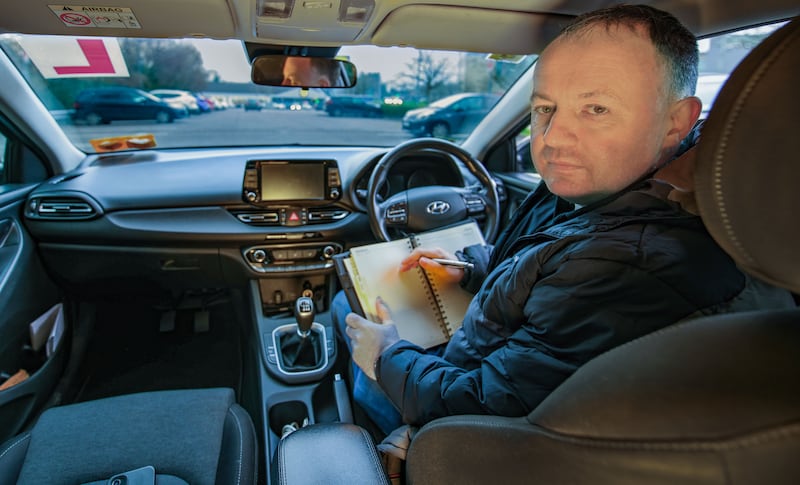My uncle had a farm and I grew up driving tractors. I’ve done a lot of rowing, too, and I loved coaching rowing, so I applied that to my driving school.
My typical learner is aged 17-22. Some are starting from scratch and some have failed the driving test with another school and are coming for more lessons. What a lot of them don’t realise is that if you just do your 12 hours’ lessons, it’s not really enough. You need to really practise between each lesson.
People need goals to improve. A lot of driving instructors might say, “You are doing grand; this is okay,” but I would push my students to improve every lesson. I tell them: you need to work on this and it needs to be better for the next lesson.
Parents’ expectations can be high. They would have been driving for two-three years, did two lessons and then passed their test. But they had built up a huge amount of experience, so they tested better. The standard of driving required to pass is probably a little bit higher now.
A lot of young people think passing the test is easier than it is. They get all the lessons done, but the reality is, it’s a process. You need to do a lesson, practise for two weeks and then do another lesson. Otherwise you are not going to progress.
People have this thing in their head, “learn when you are younger”, but I don’t fully agree with that. My belief is it’s all down to the time you put into it. Boys or girls, people aged 30, 40 or 50 – the more they practise, the better they become.
Some learners are nervous, especially if it’s their first time driving. When they know I have dual controls and I can stop the car and take control, it relaxes them. I tell them that in 14 years, I’ve never had an accident. That puts them at ease.

The thing they find trickiest is going the right speed for a gear. For the test, you have to left-reverse around a corner, turn in a space – which used to be called the three-point turn – and you must do a hill start. I think reversing around a corner is what most people find hardest.
There is a great saying in driving, “less space, less pace” – when the space tightens up, the speed should come down. Sometimes learners go through that space too quickly. They get into a tight space and feel they can continue at the same speed.
A lot of people look two or three car lengths in front of them, but you need to extend your vision farther down the road and anticipate what’s coming.
I had two US police officers and they had to do six lessons and redo their test. They couldn’t believe how strict it was. The test is longer here and testers expect much more
The people who think they are not as good as they are tend to do better. It’s nearly always the case. A good learner is someone who is willing to make changes to what they are doing.
Some arrive rushing to the lesson, and I can see it in their driving. They start the lesson rushing. I say to them, next time, don’t be rushing.
The parent is usually the sponsor, and they are supposed to be part of the whole process, but they tend to drop them off and they are gone. There is interaction, but there should probably be more interaction. Sometimes, I get the parent to sit in the back seat of the lesson if I feel I need to show them something that needs to be worked on.
Sometimes, I have people moving from the States to Killarney or Kenmare learning to drive. They get a shock when they realise the standard in Ireland.
I had two US police officers and they had to do six lessons and redo their test. They couldn’t believe how strict it was. The test is longer here and testers expect much more.

The oldest learner I had was born in 1937. They had driven an automatic in the US and had to redo their test here. They passed.
Accidents happen when drivers are not thinking ahead, they are going too fast for their driving level, coming to a bend too fast, not knowing what their car can and can’t do, maybe the tyres are a bit bald, or they get distracted by a phone or others in the car.
During Covid, people weren’t driving as much and standards went backwards. After Covid, things were calmer, but now, maybe people are busier, they are rushing to jobs and are more stressed.
I can gauge pretty well after 12 lessons who will pass. If someone is doing lessons and not practising, I tell them they need to stop doing lessons and practise.
As an instructor, you’ve got to be careful not to do too many lessons yourself. People think you just have to tell this person to go left or right, but it’s harder than you think. You are teaching, watching the road yourself, and thinking: what do I need to do to make this person a safe driver? It takes a lot out of you.
Like in rowing, I like to see that someone is improving. That’s my mindset anyway. I like to see their driving getting better and safer. I like seeing them pass their test. I like to see someone setting a goal and achieving it, that’s what I like most about it.
– In conversation with Joanne Hunt









